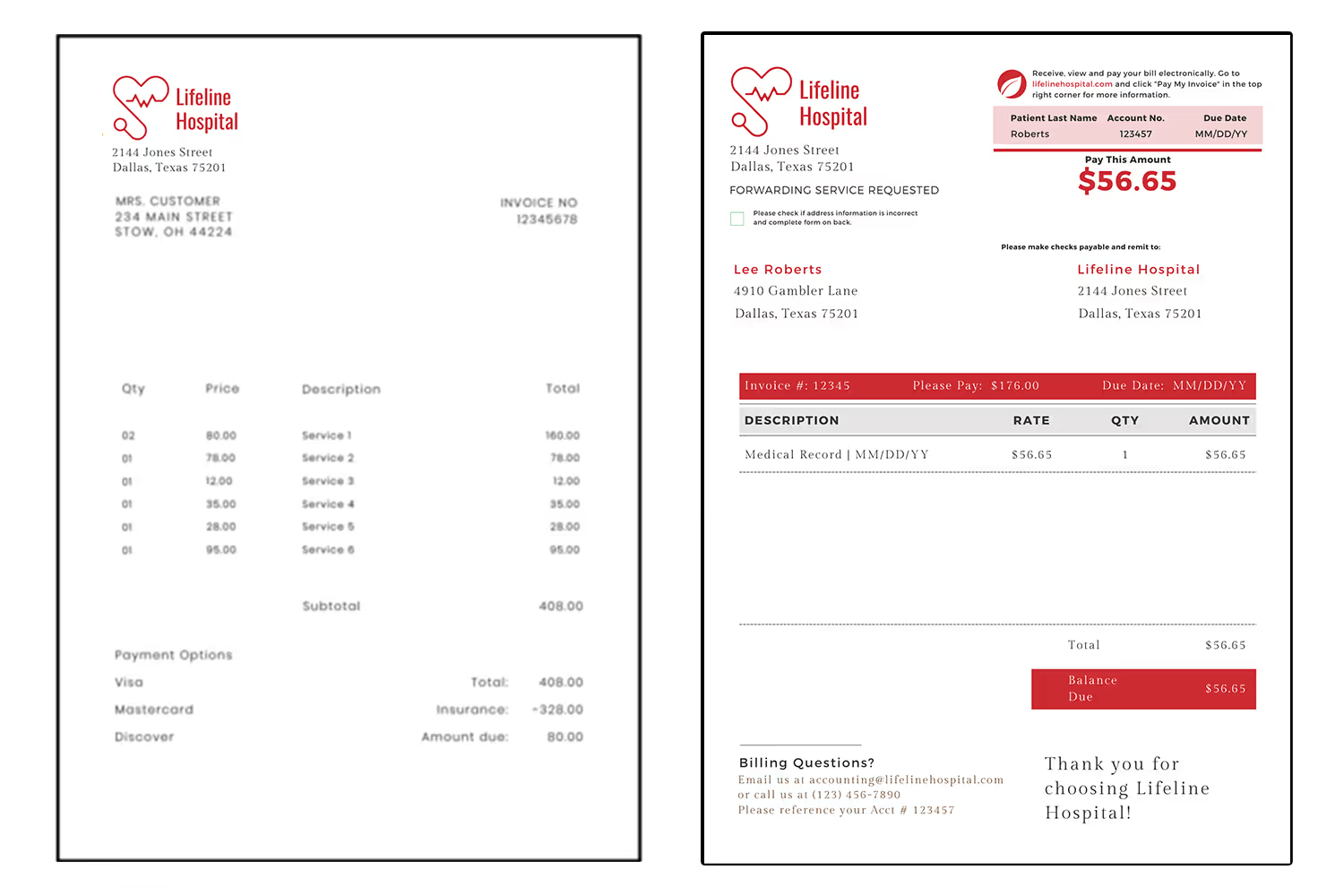4 Invoice Examples for Medical Record Requests
It isn’t uncommon for patients to receive an invoice a month after they receive the medical records that they requested. But what are the requirements for that type of invoice and what should it look like? Here are 6 example invoices for medical record requests that convert.

The truth is that patients have the right to request their medical records from a healthcare organization.
That right exists in the Health Insurance Portability and Accountability Act (HIPAA) within its Privacy rule.

This is a no-brainer, right? I mean, it’s their medical history after all.
Well, the reality is that this type of request requires a bit of work. There are two ways of providing this information.
The first way is for an authorized employee at the healthcare facility to log in to their electronic health record (EHR) system and looks through the specific patient record.
However, if the record that a patient requested is older it might require sorting through filing cabinets to find a physical copy.
Either way, when a medical record request happens an employee needs to stop what they’re doing and spend company time looking for it, obtaining it and sending it.
On a small scale, medical record requests are easy to fulfill and the facilities that receive them won’t see much of a negative impact on their bottom line.
But for large healthcare facilities that see thousands of patients per day, this process costs a lot of operational dollars. In fact, some hospital systems receive so many requests from their patients that they have entire departments devoted to the task.

For example, Dignity Health relies on its Health Information Management Department.
Since there’s so much organizational labor involved on a large scale, it isn’t uncommon for patients to receive an invoice a month after they receive the medical records that they requested.
But what are the requirements for that type of invoice and what should it look like? Here are 6 example invoices for medical record requests that convert.
Mandates and Requirements
HIPAA Minutiae
Other than granting the right for patients to request their medical records, HIPAA also provides a few additional rules on the same.
First, healthcare professionals can deny this type of request from a patient under two circumstances.

Patients cannot obtain a copy of their psychotherapy notes or if the reason why they want them is in anticipation of a civil, criminal, or administrative action.
Second, once a patient makes this type of request, healthcare providers have 30 days to respond to it according to 45 CFR 164.524(b)(2). Whether the provider accepts or denies the request is irrelevant to responding to the patient, a response has to happen.

Not being able to satisfy a medical record request within 30 days isn’t unheard of.
It’s possible that a healthcare provider doesn’t have immediate access to their patient’s PHI records. In that scenario, the provider has to notify the entity that houses their patient’s PHI of the request…thus adding a third layer. Multiple layers involved with a request could slow down the entire process.
Luckily for healthcare providers, they can request an extension on this deadline requirement.

In order to request an extension on the 30-day deadline, the healthcare provider has to provide the patient that’s requesting their records with a written statement.
This statement must…
- Include reasons for the delay and the new date that the provider can complete the request.
- Get sent to the patient must receive the written statement request within the original 30-day allotment.
Providers may only delay the initial request 1 time.
Since there are costs associated with satisfying this request (as I detailed in the introduction of this blog post), HIPAA also provides stipulations on those costs.

In a nutshell, HIPAA states that healthcare providers may pass on fees associated with patient medical record requests for labor, supplies, postage and preparation.
But what are those fees?
State-Level Statues
Yes, HIPAA is the main law that grants patients the right to request copies of their PHI and provides additional details on that type of engagement.
However, the specific details associated with fees for medical record requests get decided at a state level.
For example, Ohio Revised Code Section 3701-742 defines two different fee buckets…
- Fees for requests from a patient or patient’s personal representative
- Fees for requests from a person or entity other than a patient or patient’s personal representative
If the patient were to request a copy of their medical records in Ohio, the fees associated with that request are…
- $3.51 per page for the first ten pages 35.10
- $0.73 per page for pages 11-50 28.47
- $0.29 per page for pages 51+
- $2.35 per page for x-rays, MRI, and CAT Scans
According to the economic data organization, EMSI, patient medical records could be anywhere from 1-60 pages in length.
If the medical record that the patient requested had 60 pages and one of those pages was an x-ray, the total cost the patient would owe would be $68.53 according to the numbers above.
Let’s say that the same patient made the same request but in Texas. The fees associated with medical record requests in Washington according to WAC 246-08-400 are…
- $28.00 search fee
- $1.24 per page for pages 1-30
- $0.94 per page for pages 31+
The cost associated with the same request made in Washington would cost $66.14.
After running through both examples you can see how the prices change slightly based on the location associated with where the organization getting the request resides.
But, how do healthcare organizations pass this cost on to the patient?
Invoice 1: Uniformity
The reality is that the invoices you send for medical record requests don’t need to differ from what you’re sending through your print and mail provider for the medical services you render through your facility.
At the end of the day, any sort of invoice that comes through your facility needs to have a sense of uniformity.
In other words, the design of the invoices that come out of your facility needs to stay consistent and reflect your brand…regardless of the type of invoice that you send.

The first example invoice for medical records above shows two different bills coming from the same facility.
Although they came from the same facility, they’re different based on services. The bill on the left is the type that patients receive for visiting the hospital for an appointment. Meanwhile, the bill on the right is what patients receive for medical record requests.
You can see how the lack of cohesiveness would make it confusing for patients.
The bill on the right is much easier to comprehend, not to mention more reflective of the hospital's brand. Thus, it should be the template that the hospital goes with moving forward for all external bills.
Invoice 2: Multiple Services
It’s possible that a patient visits your facility and makes a medical record request in the same month.
Although those are two different services that your facility provides, it doesn’t mean that the patient should receive two invoices in the same month. That’s just wasteful.
Your print and mail services provider should be able to calculate both of those services and present them to the patient in one invoice.

The example invoice above includes two line items for the same patient: a medical record request and an appointment.
It’s also worth mentioning that this template is different from the first one because it includes a top-remit. A “top-remit” is short for top remittance. It provides the patient who receives it with the ability to fill in necessary payment information and returns the same, all in one motion.
Remits are a nice feature to include in all of your facility’s invoices because they make it easier for your patients to pay, thus increasing your chances of closing outstanding accounts.
Invoice 3: For Families and Guardians
When it comes to collecting from your patients as a healthcare facility, convenience is king.
You have to make it as easy as possible for your patients to understand how much they owe and how to pay you.
After all, our average attention spans nowadays are less than 8 seconds.
Outside of combining different services on the same invoice, convenience also means including line items of patients from the same family.

This next example invoice for medical record requests provides exactly that. In this example, two members of the same family received different services from the same hospital.
Beyond convenience, the reasoning for combining line items from individuals that are a part of the same family is along the same vein associated with the previous section.
Why send multiple invoices to the same address? You shouldn’t! That’s wasteful!
Of course, this template also includes another added benefit that previous templates didn’t include.
Right above the table that details the charges for each patient, there’s a text box that mentions an upcoming event at the hospital. The technical term for that text box in the invoice is a dunning message.
Dunning messages provide the ability for organizations to communicate to recipients about the status of their accounts. It also allows for organizations to advertise upcoming events, like in this example.
Invoice 4: Account On File
The best case scenario from a billing perspective is having the patient’s payment account on file.
Of course, you’re not allowed to charge anything you want to the patients that allow you to keep their payment information on file. But it’s the most ideal situation from a collections perspective because it’s the most convenient way to pay.

In order to get your patients to opt-in to allow your organization to keep their payment information on file, you need to offer payment plans.
Payment plans allow your patients to pay off any invoice they receive from you in installments, rather than as one large, expensive lump sum.
Naturally, providing payment plans as an option means allowing the same for medical record request services.
Conclusion
Patients have the right to request a copy of their medical records. They’ve had the ability to make those requests set in stone since HIPAA’s enactment in 1999.
Since there is labor involved with seeking out and providing requested medical records, facilities charge for the same as a service.
Meanwhile, state governments determine how much organizations charge for medical record retrieval services.
It’s interesting how a request that sounds so simple is actually a fairly complicated process with a lot of moving parts.
Nevertheless, the invoices you send to the patients that make medical record requests should look similar to the examples provided in this blog post. They’re designed to keep the integrity of your brand in mind while making it as easy as possible to satisfy the balance your patients owe you.
Emphasize your product's unique features or benefits to differentiate it from competitors
In nec dictum adipiscing pharetra enim etiam scelerisque dolor purus ipsum egestas cursus vulputate arcu egestas ut eu sed mollis consectetur mattis pharetra curabitur et maecenas in mattis fames consectetur ipsum quis risus mauris aliquam ornare nisl purus at ipsum nulla accumsan consectetur vestibulum suspendisse aliquam condimentum scelerisque lacinia pellentesque vestibulum condimentum turpis ligula pharetra dictum sapien facilisis sapien at sagittis et cursus congue.
- Pharetra curabitur et maecenas in mattis fames consectetur ipsum quis risus.
- Justo urna nisi auctor consequat consectetur dolor lectus blandit.
- Eget egestas volutpat lacinia vestibulum vitae mattis hendrerit.
- Ornare elit odio tellus orci bibendum dictum id sem congue enim amet diam.
Incorporate statistics or specific numbers to highlight the effectiveness or popularity of your offering
Convallis pellentesque ullamcorper sapien sed tristique fermentum proin amet quam tincidunt feugiat vitae neque quisque odio ut pellentesque ac mauris eget lectus. Pretium arcu turpis lacus sapien sit at eu sapien duis magna nunc nibh nam non ut nibh ultrices ultrices elementum egestas enim nisl sed cursus pellentesque sit dignissim enim euismod sit et convallis sed pelis viverra quam at nisl sit pharetra enim nisl nec vestibulum posuere in volutpat sed blandit neque risus.

Use time-sensitive language to encourage immediate action, such as "Limited Time Offer
Feugiat vitae neque quisque odio ut pellentesque ac mauris eget lectus. Pretium arcu turpis lacus sapien sit at eu sapien duis magna nunc nibh nam non ut nibh ultrices ultrices elementum egestas enim nisl sed cursus pellentesque sit dignissim enim euismod sit et convallis sed pelis viverra quam at nisl sit pharetra enim nisl nec vestibulum posuere in volutpat sed blandit neque risus.
- Pharetra curabitur et maecenas in mattis fames consectetur ipsum quis risus.
- Justo urna nisi auctor consequat consectetur dolor lectus blandit.
- Eget egestas volutpat lacinia vestibulum vitae mattis hendrerit.
- Ornare elit odio tellus orci bibendum dictum id sem congue enim amet diam.
Address customer pain points directly by showing how your product solves their problems
Feugiat vitae neque quisque odio ut pellentesque ac mauris eget lectus. Pretium arcu turpis lacus sapien sit at eu sapien duis magna nunc nibh nam non ut nibh ultrices ultrices elementum egestas enim nisl sed cursus pellentesque sit dignissim enim euismod sit et convallis sed pelis viverra quam at nisl sit pharetra enim nisl nec vestibulum posuere in volutpat sed blandit neque risus.
Vel etiam vel amet aenean eget in habitasse nunc duis tellus sem turpis risus aliquam ac volutpat tellus eu faucibus ullamcorper.
Tailor titles to your ideal customer segment using phrases like "Designed for Busy Professionals
Sed pretium id nibh id sit felis vitae volutpat volutpat adipiscing at sodales neque lectus mi phasellus commodo at elit suspendisse ornare faucibus lectus purus viverra in nec aliquet commodo et sed sed nisi tempor mi pellentesque arcu viverra pretium duis enim vulputate dignissim etiam ultrices vitae neque urna proin nibh diam turpis augue lacus.



![[ANSWERED] What is a Long-Term Care (LTC) Pharmacy](https://cdn.prod.website-files.com/67e2b8210878abcba6f91ae6/68d687806a075a1cf64659b0_WhatisLongTermCarePharmacy_925.avif)
